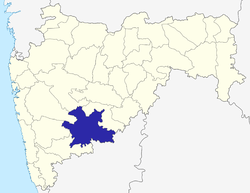Mangalwedha
| Mangalwedha | |
|---|---|
| Town | |
 Mangalwedha Location in Maharashtra, India | |
| Coordinates: 17°31′00″N 75°28′00″E / 17.51667°N 75.46667°ECoordinates: 17°31′00″N 75°28′00″E / 17.51667°N 75.46667°E | |
| Country |
|
| State | Maharashtra |
| District | Solapur |
| Population (2001) | |
| • Total | 21,694 |
| Language | |
| • Official | Marathi |
| Time zone | UTC+5:30 (IST) |
| PIN | 413305[1] |
| Vehicle registration | MH-13 |
| Website | http://www.mangalwedha.com |
Mangalwedha is a town with municipal council in Solapur district in the Indian state of Maharashtra.[2] It is the birthplace of Shri Jayatirtha also called as Teekacharya, one of the prominent saints of the Dvaita school of Vedanta.
Geography
The city of Mangalwedha is situated 55 km west of the district headquarters at Solapur and 25 km southeast of Pandharpur city.
Mangalwedha shares its boundaries with Pandharpur, Sangola, Mohol, Jath and Vijapur in Karnataka.
History
Mangalwedha is known as the "Land of Saints", as Saint Damaji, Saint Kanhopatra, Saint Basaveshwera, Saint Chokhamela were from Mangalwedha. In the 14th century, Mangalwedha was an active workplace of many saints such as Sant Damaji, Sant Chokhamela, Sant Bagadebaba, Sant Gopabai, Sant Kanhopatra, Shri Swami Samarth, Shri Sitaram Maharaj and others.[3]
Mangalwedha is also known as 'Jwariche Kothar'. Mangalwedha's Jowar(Sorghum) and Bajra have got Geographical Indications (GI) tag.
Major crops that grow in and around Mangalwedha are jowar, bajra, ground-nut and corn.
In the 14th century Mangalwedha was ruled by Bidarshahi followed by Adilshahi.
Huljanti village is known for 'Mahalingaraya' daity and there is a big fair in Diwali. Many people from Maharashtra and Karnataka come there to worship the god.
Cuisine
Mangalwedha is famous for jowar (sorghum) crop. Mangalwedha is known for its special cuisine of bhakri (a type of bread) made from jowar and salsa made from coarsely ground green chillies kharda/thecha and onion and chutney of groundnuts. Bhaji (a fritter made from gram flour) is another delicacy from Mangalwedha. It is also famous for its spicy bhel,vada pav,puri bhaji. Popular food places to visit include Jagadamba bhel,Atmashant mastani.
Demographics
As of 2011 India census,[4] Mangalwedha has population of 21,824 of which 11,109 are males while 10,715 are females. Population of Children with age of 0-6 is 2510 which is 11.50 % of total population of Mangalwedha. Female Sex Ratio is of 965 against state average of 929. Literacy rate of Mangalwedha is 81.79 % lower than state average of 82.34 %. In Mangalwedha, Male literacy is around 88.82 % while female literacy rate is 74.55 %. The town has a remarkable number of Kannada speakers along with Marathi.[5]
Villages in Mangalwedha:
- Bramhapuri ( ब्रम्हपुरी )
- Uchethan
- Bathan
- Jalihal
- Siddhankeri
- Huljanti
- Marapur
- Siddhapur
- Katral
- Kagashta
- Bhose
- Donaj
- Bawachi
- Yedrav
- Jitti
- Nimboni
- Jangalagi
- Marwadhe
- Bhalewadi
- Nandur
- Boarale
- Laxmi Dahiwadi
- Bhimnagar
- Damajinagar
- Chokhamela nagar
- Kacharewadi
- Patkhal
- Khupsangi
- Bhalawani
- Machnur
- Dhawlas
- Maroli
- Hunnur
- Mamdabad
- Lonarwadi
- Lavangi
- Salgar BK
- Salgar Khurd
- Raade
- Sidankeri
- Gonewadi
- Mundhewadi
- Nandeshwar
- Lendave Chinchale
- Shirshi
- Andhalgaov
- Ganeshwadi
- Shelewadi
People from the following villages generally come here to worship Sant Bagadebaba:
- Chikklagi
- Khandanal
- Sankh
- Daribadachi
- Madgyal
- Soradi
- Sonyal
- Vhaspet
- Aasangi
- Guddapur
- Pandharewadi
- Jadarbobla
References
- ↑ 413305
- ↑ Mahesh Bhandarkawathekar, Gopalrao Deshmukh (19 February 2015). "एक लढाई : शिवरायांची दख्खन स्वारी अन् मंगळवेढा भेट, मुघलांनी घेतली माघार" [Ēk Laḍhā'ī: Śivarāyān̄cī Dakhkhan Svārī An Maṅgaḷvēḍhā Bhēṭ, Mughalānnī Ghētlī Māghār]. Divya Marathi (in Marathi). Pandharpur. Retrieved 10 June 2015.
- ↑ "Archived copy". Archived from the original on 2011-07-14. Retrieved 2009-04-10.
- ↑ "Census 2011". https://www.census2011.co.in/. Census Commission of India. External link in
|website=(help) - ↑ The Dynasties of the Kanarese Districts of the Bombay Presidency"(1894) J.F.Fleet, Gazetteer of the Bombay Presidency (Vol-1, Part-II, Book-III)
ISBN 81-206-0277-3. templatestyles stripmarker in
|title=at position 146 (help)
